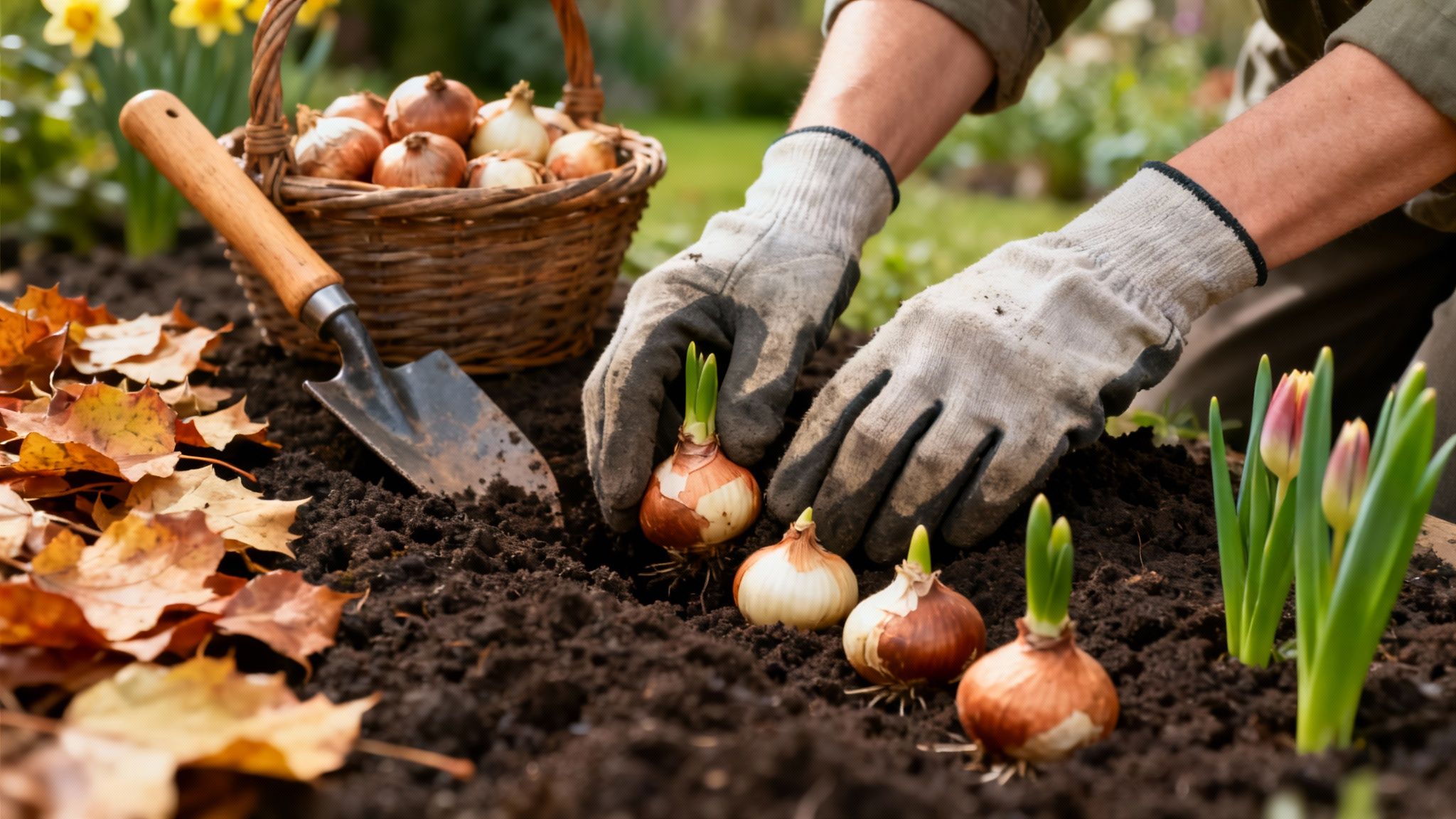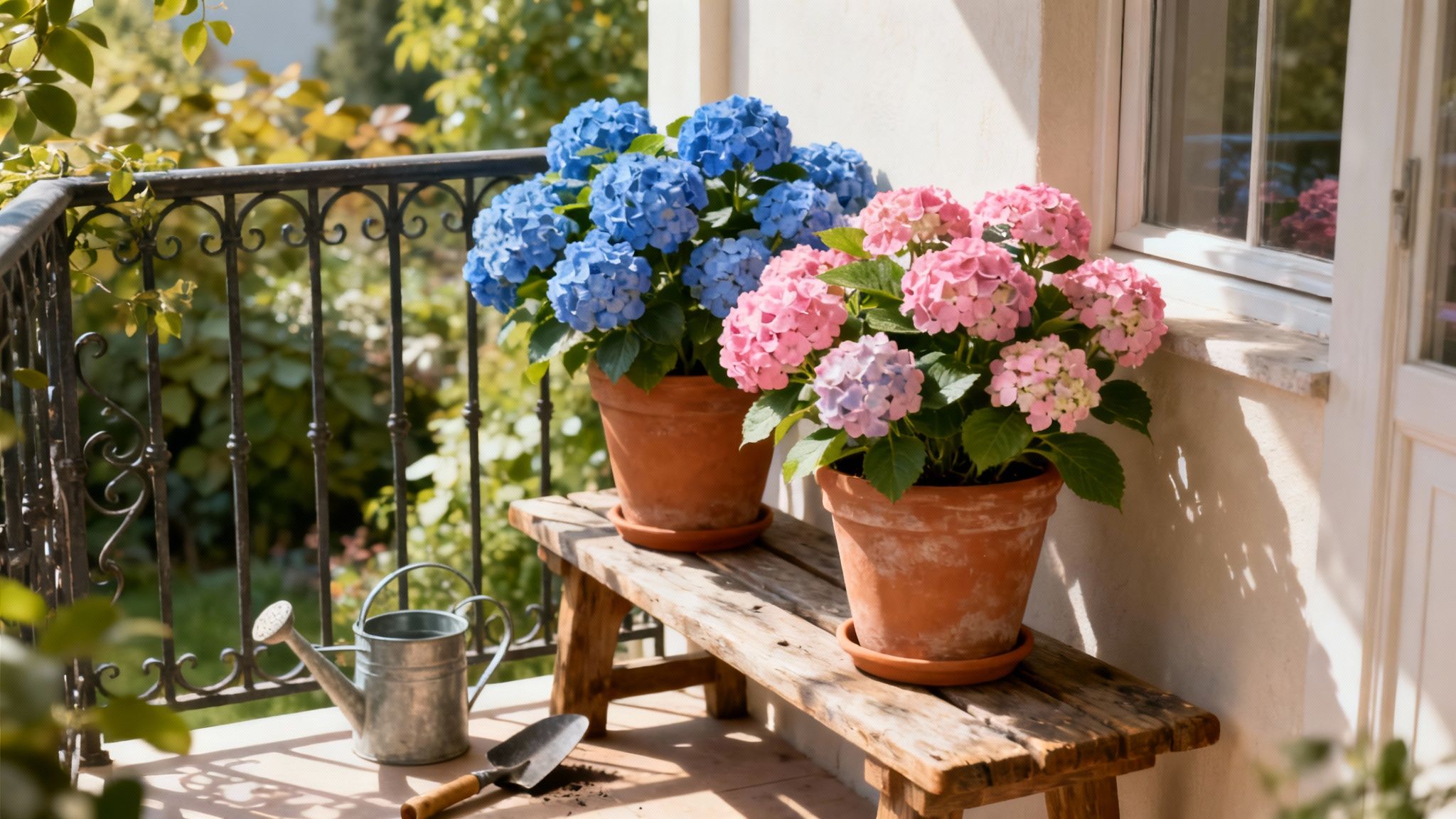The kitchen is the heart of the home, a space for culinary creation, late-night chats, and morning coffee rituals. The floor you choose is its foundation, setting the tone for the entire room's design and functionality. It needs to withstand spills, dropped utensils, and constant foot traffic while looking effortlessly stylish. With so many materials available, from timeless natural stone to innovative luxury vinyl, finding the perfect fit can feel overwhelming.
This guide presents nine standout flooring ideas for kitchens, breaking down the essential details you need to make a confident and informed choice. We'll explore the unique pros and cons of each material, covering everything from durability and maintenance requirements to cost considerations and aesthetic potential.
Forget generic advice. Instead, we offer practical tips and fresh perspectives to inspire your next renovation project. Whether you're drawn to the classic elegance of engineered hardwood, the industrial chic of concrete, or the sustainable warmth of cork, this roundup will equip you with the knowledge to select a floor that not only complements your style but also supports the demands of a busy modern kitchen. Let's find the perfect foundation for your home.
1. Ceramic and Porcelain Tile
A timeless and practical choice, ceramic and porcelain tiles are a classic for a reason. These fired clay products offer exceptional durability and superior water resistance, making them one of the best flooring ideas for kitchen environments. Porcelain is a subtype of ceramic that is fired at higher temperatures, resulting in a denser, harder, and less porous material. This makes it exceptionally well-suited for high-traffic, high-moisture areas like the kitchen.
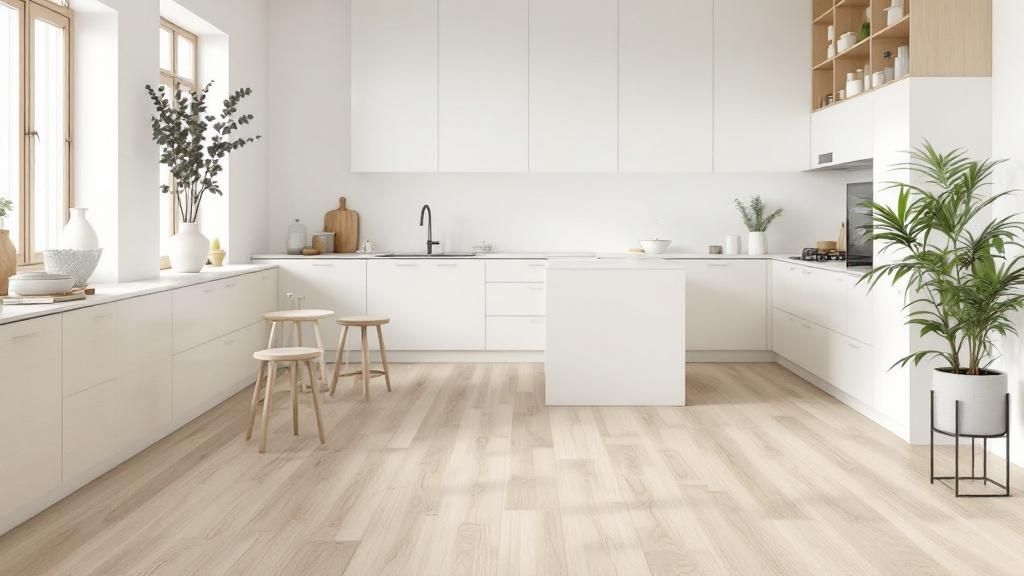
The design versatility is nearly limitless. You can find tiles in a vast array of colours, patterns, sizes, and finishes. Major brands like Daltile, American Olean, and MSI Surfaces have popularised everything from large-format porcelain planks that convincingly mimic natural hardwood to intricate hexagonal mosaics for a vintage-inspired aesthetic. This flexibility allows tile to fit seamlessly into any design scheme, from modern farmhouse to ultra-contemporary.
Implementation and Styling Tips
To get the most out of your tile flooring, consider these actionable tips:
- Minimise Grout Lines: Opt for rectified tiles, which are precisely cut after firing. This allows for very thin grout lines (as narrow as 1.5mm), creating a sleek, almost seamless look.
- Smart Grout Colour: While white grout looks fresh initially, it is prone to staining. Consider a darker grout colour like grey or charcoal to camouflage everyday spills and dirt, reducing cleaning stress.
- Add Warmth Underfoot: Tile can feel cold, especially during UK winters. Installing an underfloor heating system beneath your tiles provides luxurious comfort and can be an energy-efficient way to heat the room.
- Protect Your Grout: Grout is porous and can absorb moisture and stains. Applying a high-quality grout sealant after installation and re-sealing it annually will prolong its life and keep it looking clean.
2. Luxury Vinyl Plank (LVP)
A hugely popular and versatile option, Luxury Vinyl Plank (LVP) has revolutionised the market for flooring ideas for kitchen spaces. This is a multi-layered synthetic flooring product designed to realistically mimic natural materials like hardwood or stone. Comprising a durable wear layer, a high-definition printed design layer, a rigid core, and a backing, modern LVP offers exceptional durability and is typically 100% waterproof, making it a perfect fit for the spills and splashes common in kitchens.
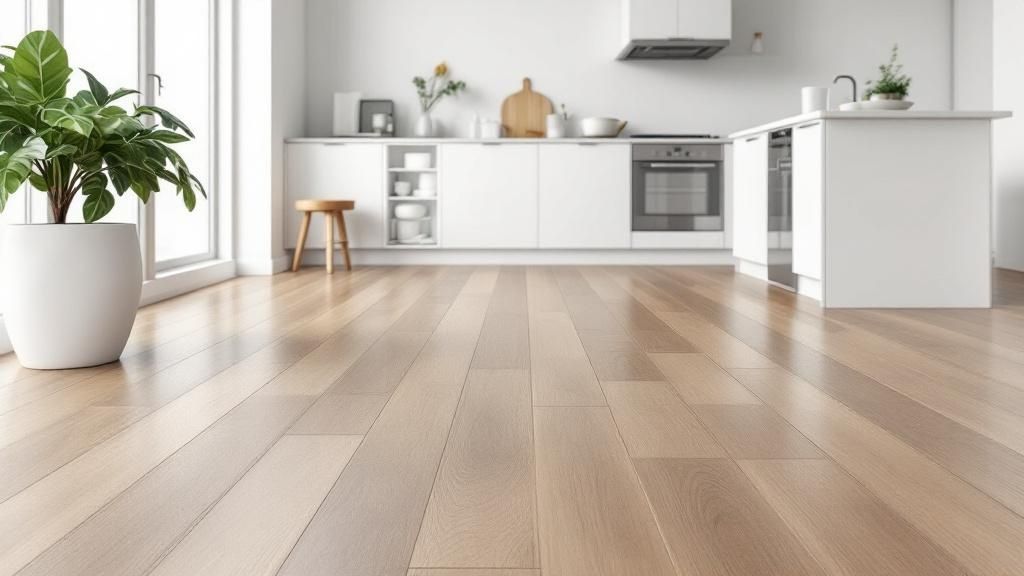
The realism of LVP is truly remarkable. Leading brands such as Karndean, COREtec, and Mannington have perfected the technology to create textures and visuals that are almost indistinguishable from the real thing. You can find everything from wide, rustic oak planks that add warmth to a farmhouse kitchen to sleek, slate-effect tiles for a more industrial feel. Products like Shaw Floorte Pro are often seen in modern, open-concept homes due to their seamless look and resilience.
Implementation and Styling Tips
To ensure your LVP floor looks its best and performs well over time, consider these practical tips:
- Prioritise the Wear Layer: For a busy area like the kitchen, choose a plank with a thick wear layer. A minimum of 0.5mm (or 20 mil) is recommended to resist scratches, scuffs, and dents from daily foot traffic and dropped utensils.
- Acclimatise Before Laying: LVP needs to adjust to your home's temperature and humidity. Let the unopened boxes of planks lie flat in the kitchen for at least 48 hours before installation to prevent buckling or gapping later.
- Allow for Expansion: LVP expands and contracts slightly with temperature changes. Leave a small expansion gap (usually 6-10mm) around the perimeter of the room and cover it with quarter-round moulding or skirting boards for a professional, finished look.
- Follow Cleaning Guidelines: Avoid harsh chemicals or steam mops, which can damage the wear layer. Clean your LVP floor using a pH-neutral cleaner recommended by the manufacturer to maintain its warranty and appearance.
3. Natural Stone
For a truly luxurious and one-of-a-kind kitchen floor, natural stone is an unparalleled choice. Each slab, whether granite, marble, limestone, or slate, is a unique piece of art crafted by nature, offering distinct colours, veining, and patterns. This inherent uniqueness provides timeless elegance and a substantial, high-end feel, making it one of the most aspirational flooring ideas for kitchen designs aiming for a sophisticated and enduring aesthetic. Its durability is a key advantage, promising a surface that can last a lifetime with proper care.
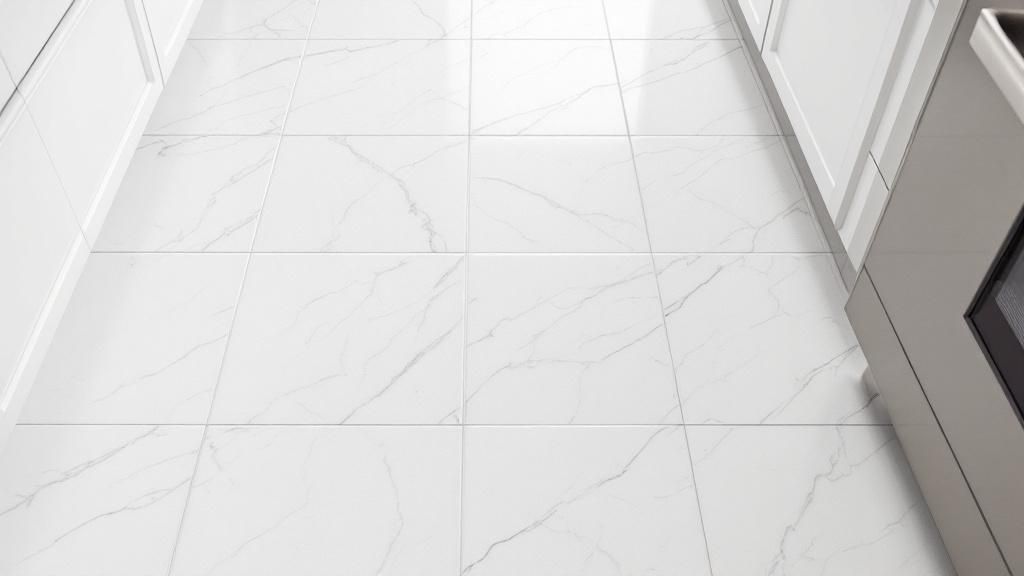
The versatility of natural stone allows it to complement various kitchen styles. For example, polished Carrara marble is a hallmark of luxury kitchens, while honed slate tiles can create a rustic, earthy atmosphere. In contemporary homes, large-format honed granite tiles offer a sleek, monolithic look, and tumbled travertine is often chosen for Mediterranean-inspired spaces. Suppliers affiliated with the Natural Stone Institute provide access to a vast global selection, ensuring a perfect match for any vision.
Implementation and Styling Tips
To ensure your natural stone floor remains a stunning feature, follow these practical tips:
- Seal it Diligently: Natural stone is porous and susceptible to staining and moisture damage. It is crucial to apply a high-quality impregnating sealer upon installation and re-seal it every 1-2 years, or as recommended by the stone supplier.
- Choose the Right Finish: A honed finish has a matte, non-reflective surface that is excellent at hiding minor scratches and scuffs, making it a practical choice for a high-traffic kitchen. A polished finish, while beautiful, will show wear more readily.
- Act Fast on Spills: Acidic substances like lemon juice, vinegar, or wine can etch the surface of stones like marble and limestone. Clean up all spills immediately with a soft cloth to prevent permanent damage.
- Use pH-Neutral Cleaners: Avoid harsh, acidic, or abrasive cleaning products. Stick to cleaners specifically formulated for natural stone that have a neutral pH to protect the stone and its sealant.
4. Engineered Hardwood
For those who love the unmistakable warmth and beauty of real wood, engineered hardwood offers a more practical solution for the kitchen environment. It consists of a genuine hardwood veneer layered over a core of plywood or high-density fibreboard (HDF). This layered construction provides superior stability against the temperature and humidity fluctuations common in kitchens, making it less prone to warping or gapping than solid hardwood. It successfully delivers the authentic look and feel of real wood, making it one of the most desirable flooring ideas for kitchen designs aiming for a natural, high-end finish.
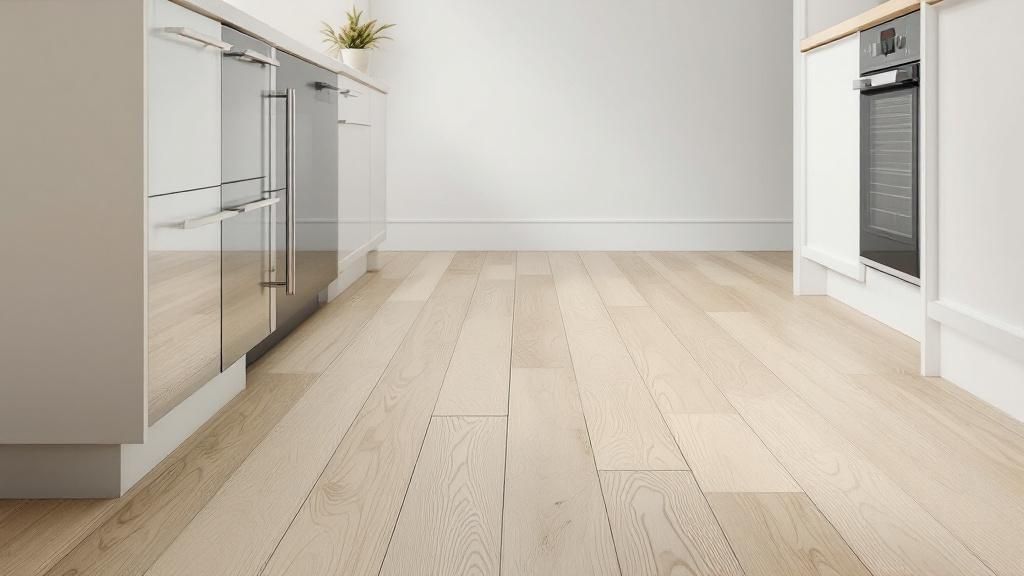
The design possibilities are vast, allowing it to integrate into numerous aesthetics. Leading brands such as Bruce Flooring and Armstrong have popularised everything from wide-plank white oak, perfect for modern farmhouse kitchens, to rich, exotic Brazilian cherry for a touch of luxury. You can also find hand-scraped hickory finishes that add character and a rustic feel. This adaptability ensures that engineered wood can elevate any kitchen, from traditional to contemporary, with its timeless appeal. Finishing products from specialists like Bona help maintain its lustre and durability for years.
Implementation and Styling Tips
To ensure your engineered hardwood flooring performs beautifully and lasts, consider these key tips:
- Prioritise Wear Layer Thickness: For longevity, choose planks with a thicker wear layer (4mm or more). This top layer of real wood determines how many times the floor can be sanded and refinished, significantly extending its lifespan.
- Maintain Stable Humidity: Engineered wood is more stable than solid wood, but it still requires a consistent environment. Aim to keep your home's humidity levels between 30-50% to prevent excessive expansion or contraction.
- Use Protective Area Rugs: Place stylish area rugs or mats in high-spill zones, such as near the sink or dishwasher. This protects the wood from standing water and adds a layer of comfort underfoot.
- Clean with Care: Avoid using generic floor cleaners, steamers, or excessive water. Clean spills immediately and use a pH-neutral cleaner specifically formulated for hardwood floors to protect the finish.
5. Concrete Flooring
Once confined to industrial spaces and garages, concrete has emerged as a chic and surprisingly versatile option for contemporary kitchen flooring. This approach involves either polishing an existing concrete slab or pouring a new, specialised concrete overlay. Modern techniques in staining, stamping, and polishing transform this utilitarian material into a sophisticated surface that delivers a unique, high-end aesthetic perfect for modern, industrial, or minimalist designs.
The appeal of concrete lies in its raw beauty and immense durability. It can be coloured to match any palette, from earthy neutrals to bold, vibrant hues, using stains from brands like Behr. The surface can be polished to a high-gloss finish for a sleek, reflective look or kept matte for a more understated, organic feel. This adaptability makes it one of the most customisable flooring ideas for a kitchen, allowing it to seamlessly integrate into various architectural styles.
Implementation and Styling Tips
To achieve a functional and stylish concrete floor, consider these expert recommendations:
- Install Radiant Heating: Concrete is notoriously cold underfoot. Embedding an underfloor heating system during installation is a highly effective way to add luxurious warmth and comfort, making the space more inviting, especially on chilly mornings.
- Apply a Quality Sealer: Raw concrete is porous and susceptible to stains from spills like wine, oil, or acidic foods. Applying a high-performance, food-safe sealant is crucial to protect the surface, prevent absorption, and make cleaning much easier.
- Use Anti-Fatigue Mats: The hardness of concrete can be tough on joints during long periods of standing, such as when cooking or washing up. Strategically placing cushioned anti-fatigue mats in primary work zones like by the sink and cooker can significantly improve comfort.
- Consider Micro-Topping: If you have an existing subfloor that isn't concrete, you don't have to miss out. A micro-topping or concrete overlay, a thin polymer-modified cement layer, can be applied over existing stable surfaces like wood or tile to achieve the concrete look without a major structural pour.
6. Laminate Flooring
Once seen as a purely budget option, modern laminate has undergone a significant transformation, emerging as a durable and stylish contender for kitchen flooring. Laminate flooring is a multi-layered synthetic product, consisting of a photographic layer that mimics wood or stone, fused to a high-density fibreboard core and protected by a clear wear layer. This construction makes it a fantastic, cost-effective alternative to hardwood or stone, offering impressive realism and easy installation.
The evolution in laminate technology is evident in the products offered by leading brands like Pergo, Quick-Step, and Mohawk. Innovations such as Mohawk's RevWood line provide fully waterproof options, addressing the historical concern of moisture damage in kitchens. Whether it's the rustic charm of Pergo TimberCraft for a farmhouse kitchen or the sleek lines of a Quick-Step Perspective floor in a contemporary space, today's laminate provides sophisticated flooring ideas for kitchen designs without the high price tag.
Implementation and Styling Tips
To achieve a professional and long-lasting finish with laminate, consider these practical tips:
- Prioritise Water Resistance: For a kitchen, always choose a laminate specifically labelled as water-resistant or waterproof. This feature, often found in ranges with sealed edges and hydrophobic coatings, is crucial for protecting the fibreboard core from spills and moisture.
- Use Quality Underlayment: A proper underlayment is essential. It not only improves the feel underfoot but also provides crucial sound dampening, reducing the hollow sound sometimes associated with laminate floors.
- Respect Expansion Gaps: Laminate expands and contracts with changes in temperature and humidity. A small expansion gap (typically 8-10mm) must be left around the perimeter of the room, which will be covered by skirting boards or beading.
- Clean with Care: Avoid using steam mops or excessive water. Clean your floor with a microfibre mop and a manufacturer-recommended, pH-neutral laminate cleaner to preserve the protective wear layer and prevent damage.
7. Cork Flooring
An exceptionally comfortable and sustainable choice, cork flooring is an outstanding flooring idea for kitchens where comfort and eco-friendliness are priorities. Harvested from the regenerating bark of cork oak trees, this material is both renewable and biodegradable. The cork is compressed into planks or tiles, offering natural cushioning underfoot that reduces strain on joints and minimises noise, making for a quieter, more comfortable kitchen environment.
Far from being a one-note material, modern cork flooring is remarkably versatile. Leading brands like Amorim and US Floors offer a wide range of colours, patterns, and finishes. You can find everything from natural cork tiles that bring an earthy warmth to eco-friendly homes, to sleek, coloured planks that complement contemporary designs. Its natural antimicrobial properties also help to resist mould and mildew, adding a layer of hygenic assurance to the heart of your home.
Implementation and Styling Tips
To ensure your cork kitchen floor performs beautifully for years to come, consider these practical tips:
- Prioritise Sealing: While cork has some natural water resistance, it is not waterproof. Ensure your floor is finished with a high-quality, water-based polyurethane sealant upon installation. This protective layer should be reapplied every few years to guard against spills and moisture ingress.
- Prevent Dents: Cork is soft, which makes it comfortable but also susceptible to denting from heavy furniture or dropped objects. Use felt furniture pads under the legs of tables, chairs, and freestanding islands to distribute the weight and prevent permanent marks.
- Gentle Cleaning Routine: To maintain the finish and integrity of your cork floor, avoid harsh chemicals. Clean spills promptly and use a pH-neutral cleaner with a damp, not soaking wet, mop for regular upkeep.
- Choose High-Density Options: For a high-traffic area like the kitchen, opt for high-density cork flooring. These products are more durable and better equipped to handle the daily demands of a busy household, offering a great balance of comfort and resilience.
8. Rubber Flooring
Once confined to commercial gyms and professional kitchens, rubber flooring is a bold and highly practical choice making its way into modern homes. Comprised of either natural or synthetic rubber, it is available in tiles, sheets, or planks, offering outstanding resilience, comfort, and slip resistance. This makes it one of the most functional and safest flooring ideas for kitchen spaces, especially for households with children or elderly members.
The unique cushioned feel of rubber provides exceptional underfoot comfort, reducing fatigue during long periods of standing while cooking or cleaning. Brands like Pirelli, Roppe, and Flexco have popularised its use beyond commercial settings, showcasing its aesthetic potential. You can find it in a surprising range of colours and textures, from classic studded patterns to smooth, contemporary finishes, allowing it to complement industrial, minimalist, or even vibrantly eclectic kitchen designs.
Implementation and Styling Tips
To ensure your rubber kitchen floor is both beautiful and long-lasting, follow these key tips:
- Prioritise Slip Resistance: Not all rubber flooring is created equal. Look for products with a textured surface or a high slip-resistance rating (often indicated by an R-rating) to maximise safety in a spill-prone area.
- Use Entrance Mats: Place high-quality mats at kitchen entrances to trap dirt, grit, and moisture. This simple step dramatically reduces wear and tear and minimises the amount of abrasive debris tracked onto the floor.
- Clean with Care: Rubber can be damaged by harsh chemicals. Avoid petroleum-based solvents, grease-cutting detergents, and abrasive cleaners. Use a pH-neutral cleaner and a damp mop for regular maintenance.
- Ensure Professional Sealing: While inherently water-resistant, the seams in rubber tile or plank installations can be vulnerable. Ensure a professional applies a suitable sealant, especially around high-moisture zones like the sink and dishwasher, to create a fully waterproof surface.
9. Bamboo Flooring
An increasingly popular eco-conscious choice, bamboo offers the warmth and aesthetic of hardwood but is derived from a highly renewable grass. Bamboo is harvested, processed, and compressed into durable planks. Its sustainability credentials, combined with a clean, modern look, make it an attractive option for homeowners looking for unique flooring ideas for their kitchen. The most robust variant, strand-woven bamboo, is exceptionally hard and resilient, often surpassing the durability of traditional oak.
The versatility of bamboo allows it to integrate into various kitchen designs. Brands like Cali Bamboo, Teragren, and Ambient have expanded the market with a range of styles. For instance, natural bamboo has a light, blonde colour perfect for minimalist or Scandinavian-inspired kitchens. Carbonised bamboo is steam-treated to achieve a richer, coffee-like hue, while strand-woven varieties offer impressive hardness suitable for busy family kitchens. Click-lock systems also make it a viable project for confident DIY enthusiasts.
Implementation and Styling Tips
To ensure your bamboo floor performs well and looks its best, follow these practical tips:
- Prioritise Strand-Woven: For a high-traffic area like a kitchen, always opt for strand-woven bamboo. It is significantly harder and more resistant to dents and scratches than traditional horizontal or vertical bamboo planks.
- Check for Certifications: Ensure the product has low-VOC (volatile organic compound) and low-formaldehyde credentials, like those certified by FloorScore®. This is crucial for maintaining good indoor air quality in your home.
- Acclimatise Before Laying: Bamboo is a natural material that expands and contracts with changes in temperature and humidity. Let the planks acclimatise inside your kitchen for at least 72 hours before installation to prevent buckling or gapping later on.
- Manage Moisture Levels: While relatively water-resistant, bamboo is not waterproof. Clean up spills promptly and use mats in front of the sink and dishwasher. Maintaining consistent indoor humidity is key to its long-term stability.
Kitchen Flooring Options Comparison Matrix
Choosing the Right Floor for Your Culinary Hub
Navigating the vast landscape of kitchen flooring can feel overwhelming, but as we have explored, the perfect foundation for your culinary hub is within reach. We have journeyed through a diverse range of options, from the timeless elegance and robust nature of ceramic and porcelain tiles to the warm, sustainable appeal of cork and bamboo. We have seen how modern marvels like luxury vinyl plank (LVP) offer unparalleled realism and water resistance, while materials like polished concrete provide an edgy, industrial-chic aesthetic that is both durable and unique.
The central takeaway is that there is no single "best" choice, only the choice that is best for you. Your decision-making process should be a careful balance of three core pillars: Lifestyle, Aesthetics, and Budget. Consider the daily realities of your home. Is it a bustling family centre with constant spills and heavy foot traffic, or a quiet space for culinary creativity? Your answer will guide you towards materials praised for durability and low maintenance, such as porcelain or LVP. Conversely, if aesthetic harmony with a classic or rustic design is paramount, engineered hardwood or natural stone might be your leading contenders.
Actionable Next Steps to Finalise Your Choice
With these flooring ideas for your kitchen now in mind, it is time to move from inspiration to implementation. Here is a clear path forward:
- Create a Shortlist: Based on our detailed breakdown, select your top three flooring materials that align with your core needs. Revisit the pros and cons we outlined for each.
- Order Samples: This is a non-negotiable step. Seeing a material online or in a showroom is vastly different from experiencing it in your own home. Place samples on the floor and observe how they look under your kitchen's natural and artificial light throughout the day.
- Perform a 'Life Test': Do not be gentle with your samples. Spill a little water on the LVP, drop a spoon on the laminate, and walk on the cork barefoot. How do they feel? How easy are they to clean? This practical test provides invaluable insights that no product description can match.
- Consult a Professional: Once you have a favourite, get a quote from a reputable local installer. They can assess your subfloor, confirm suitability, and provide an accurate cost projection, preventing any unwelcome surprises down the line.
Ultimately, investing time in selecting the right kitchen flooring is an investment in your home's daily function and overall value. The floor is the stage upon which your life unfolds, from hurried weekday breakfasts to celebratory dinners. By choosing wisely, you create a space that is not only beautiful and resilient but also a true reflection of your personal style, ensuring your kitchen remains the heart of your home for many years to come.


